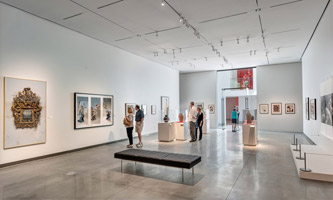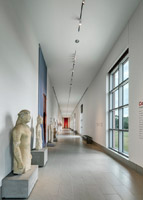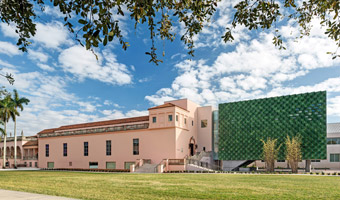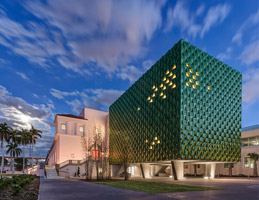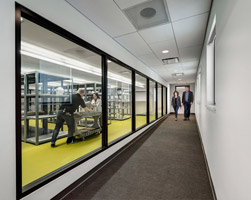The Center for Asian Art
in the Dr. Helga Wall-Apelt Gallery of Asian Art
at the Ringling Museum

The Center for Asian Art in the Dr. Helga Wall-Apelt Gallery of Asian Art promotes the exploration of historical and contemporary Asian art through exhibitions, research, and programs celebrating the breadth and depth of Asian artistic achievements. The Center underscores The Ringling’s commitment to and investment in the arts of Asia, allowing it to cultivate strategic partnerships with individuals and institutions around the globe.
The Center helps to make Sarasota and The Ringling an important resource for both scholars and enthusiasts of Asian arts and culture. The 25,000-square-foot Center includes galleries dedicated to rotating installations of The Ringling’s Asian art holdings, a 125-seat lecture hall, an object and print study room, and open storage spaces to increase public access to the collections.
Legacy of Asian art at The Ringling
John and Mable Ringling first purchased artwork from China, Japan, India and Southeast Asia in the 1920s. Over time, The Ringling’s Asian art collection has grown and diversified through major gifts from many generous donors, several of which will be showcased in the new Center. The Ringling is also actively acquiring works of art to make the collection even more inclusive. Over the years The Ringling has showcased numerous historic and contemporary exhibitions devoted to Asian art as well as a wealth of Asian-related performances, programs and events.
The role and the importance of Dr. Helga Wall-Apelts contributions
A generous financial gift from Dr. Helga Wall-Apelt assisted in the refocus on the arts and culture of Asia. We greatly appreciate Dr. Helga Wall-Apelt’s generous lead gift towards the creation of the Center and the endowment of a curatorial position named in honor of her gift.
Architecture as work of art
The Ringling commissioned the renowned architectural and design firm Machado Silvetti, based in Boston, to design the new Center. The project involved remodeling existing spaces in the Museum of Art and merging them with a distinctive new addition, following the guidelines of the National Register of Historic Places, on which The Ringling is included.
The new pavilion is itself a work of art, its façade a mosaic of custom green-glazed terra cotta tiles, which were designed to respond to the tonality and textures of The Ringling’s architecture and landscape, and were inspired by the shades of jade found in Asian art, garden ornaments, and pavilions. The overall goal was to create an architecturally significant and unique building that would elicit inventive new approaches and responses to Asian art and culture.
Educational opportunites and community outreach
The Center for Asian Art provides The Ringling and its parent institution, Florida State University, a leading research university, with the ability to connect with faculty and students across the region and the globe on a dynamic new level. In future years, we plan to offer undergraduate and graduate Asian art history seminars, primarily geared toward FSU and local college students, and scholars from a range of fields will be in residence to conduct research for publication and presentation.
The lecture hall hosts visiting specialists and artists. Visitors from around the world are able to experience objects up close in the study room, and public programs for all ages focused on the arts and cultures of Asia will be expanded.
Opening of the Center
As a prelude to the opening of the Center for Asian Art in February of 2016, The Ringling had two special exhibitions on view in the Searing Wing—Samurai: The Way of the Warrior on loan from the Museo Stibbert in Florence, Italy, and Ink, Silk and Gold: Islamic Art from the Museum of Fine Arts, Boston. On February 19th the Center was opened to the public. On May 15th a Grand Opening and Community Festival was held; The Ringling invited the community to an exciting and enriching celebration of Asian arts and cultures, which included engaging performances, storytelling, art-making activities, games, demonstrations, culinary tours, and gallery guides for visitors of all ages.
The Galleries
The Galleria
Display of artwork that depicts the cultural exchange that occurred between the West and the cultures of Asia. From the Cypriot objects derived from the ancient world to the exchange that took place along the Silk Road and the sea routes that connected the West and the continent of Asia.
Chao Gallery
Divided by geographic area – Japan, China, India, and Southeast Asia. Includes, for example:
Japan: altar pieces, vignettes, Genji screens, woodblock prints.
China: Early bronze and jade objects; the Koger porcelain, which will be configured in a style that suggests a scholar’s studio.
India: Buddhist, Hindu, and Jain sculpture Southeast Asia: ceramics and sculpture Nepal and Tibet: sculpture.
Pavilion Gallery
Featured in this gallery are works by Asian artists who are applying traditional themes and techniques in new and different ways. Twentieth-century prints demonstrate how Japanese artists absorbed new ideas from Western art to make innovations in woodblock printing, an important Asian artistic tradition.

